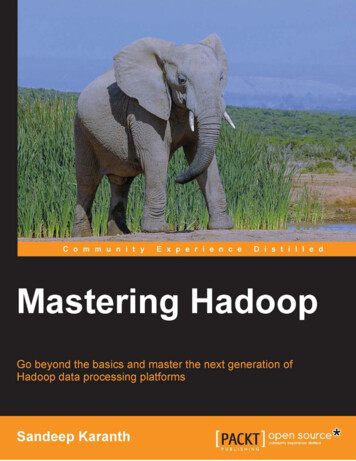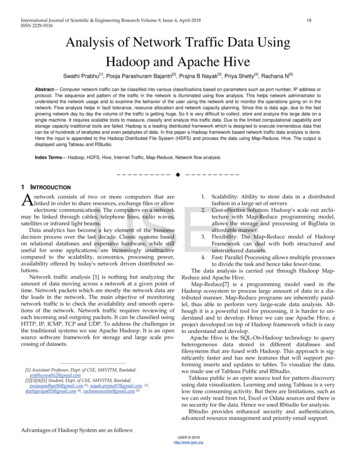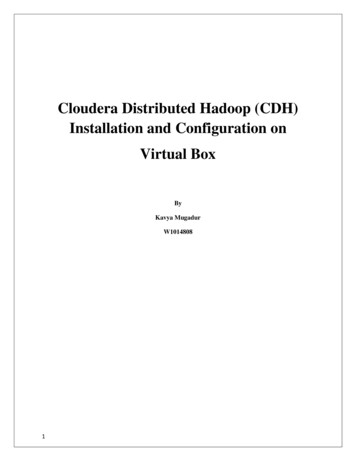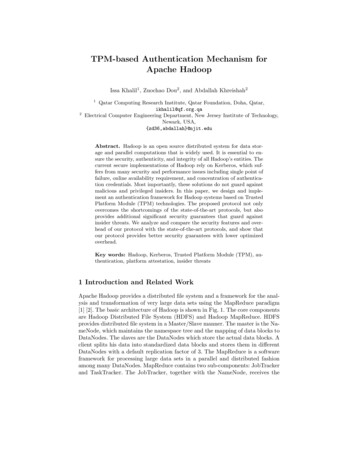
Transcription
Apache Hadoop TutorialiApache Hadoop Tutorial
Apache Hadoop TutorialiiContents1Introduction12Setup22.1Setup "Single Node" . . . . . . . . . . . . . . . . . . . . . . . . . . . . . . . . . . . . . . . . . . . . . . . . .22.2Setup "Cluster" . . . . . . . . . . . . . . . . . . . . . . . . . . . . . . . . . . . . . . . . . . . . . . . . . . . .33456HDFS53.1HDFS Architecture . . . . . . . . . . . . . . . . . . . . . . . . . . . . . . . . . . . . . . . . . . . . . . . . . .53.2HDFS User Guide . . . . . . . . . . . . . . . . . . . . . . . . . . . . . . . . . . . . . . . . . . . . . . . . . . .6MapReduce94.1MapReduce Architecture . . . . . . . . . . . . . . . . . . . . . . . . . . . . . . . . . . . . . . . . . . . . . . .94.2MapReduce example . . . . . . . . . . . . . . . . . . . . . . . . . . . . . . . . . . . . . . . . . . . . . . . . . 10YARN145.1YARN Architecture . . . . . . . . . . . . . . . . . . . . . . . . . . . . . . . . . . . . . . . . . . . . . . . . . . 145.2YARN Example . . . . . . . . . . . . . . . . . . . . . . . . . . . . . . . . . . . . . . . . . . . . . . . . . . . . 16Download18
Apache Hadoop TutorialCopyright (c) Exelixis Media P.C., 2016All rights reserved. Without limiting the rights undercopyright reserved above, no part of this publicationmay be reproduced, stored or introduced into a retrieval system, ortransmitted, in any form or by any means (electronic, mechanical,photocopying, recording or otherwise), without the prior writtenpermission of the copyright owner.iii
Apache Hadoop TutorialivPrefaceApache Hadoop is an open-source software framework written in Java for distributed storage and distributed processing of verylarge data sets on computer clusters built from commodity hardware. All the modules in Hadoop are designed with a fundamentalassumption that hardware failures are common and should be automatically handled by the framework.Hadoop has become the de-facto tool used for Distributed computing. For this reason we have provided an abundance of tutorialshere at Java Code Geeks, most of which can be found here: ise-java/apachehadoop/Now, we wanted to create a standalone, reference post to provide a framework on how to work with Hadoop and help you quicklykick-start your own applications. Enjoy!
Apache Hadoop TutorialvAbout the AuthorMartin is a software engineer with more than 10 years of experience in software development. He has been involved in different positions in application development in a variety of software projects ranging from reusable software components, mobileapplications over fat-client GUI projects up to larg-scale, clustered enterprise applications with real-time requirements.After finishing his studies of computer science with a diploma, Martin worked as a Java developer and consultant for internationaloperating insurance companies. Later on he designed and implemented web applications and fat-client applications for companieson the energy market. Currently Martin works for an international operating company in the Java EE domain and is concernedin his day-to-day work with larg-scale big data systems.His current interests include Java EE, web applications with focus on HTML5 and performance optimizations. When timepermits, he works on open source projects, some of them can be found at this github account. Martin is blogging at Martin’sDeveloper World.
Apache Hadoop Tutorial1 / 18Chapter 1IntroductionApache Hadoop is a framework designed for the processing of big data sets distributed over large sets of machines with commodity hardware. The basic ideas have been taken from the Google File System (GFS or GoogleFS) as presented in this paperand the MapReduce paper.A key advantage of Apache Hadoop is its design for scalability, i.e. it is easy to add new hardware to extend an existing clusterin means of storage and computation power. In contrast to other solutions the used principles do not rely on the hardware andassume it is highly available, but rather accept the fact that single machines can fail and that in such case their job has to bedone by other machines in the same cluster without any interaction by the user. This way huge and reliable clusters can be buildwithout investing in expensive hardware.The Apache Hadoop project encompasses the following modules: Hadoop Common: Utilities that are used by the other modules. Hadoop Distributed File System (HDFS): A distributed file system similar to the one developed by Google under the nameGFS. Hadoop YARN: This module provides the job scheduling resources used by the MapReduce framework. Hadoop MapReduce: A framework designed to process huge amount of dataThe modules listed above form somehow the core of Apache Hadoop, while the ecosystem contains a lot of Hadoop-relatedprojects like Avro, HBase, Hive or Spark.
Apache Hadoop Tutorial2 / 18Chapter 2Setup2.1Setup "Single Node"In order to get started, we are going to install Apache Hadoop on a single cluster node. This type of installation only serves thepurpose to have a running Hadoop installation in order to get your hands dirty. Of course you don’t have the benefits of a realcluster, but this installation is sufficient to work through the rest of the tutorial.While it is possible to install Apache Hadoop on a Windows operating system, GNU/Linux is the basic development and production platform. In order to install Apache Hadoop, the following two requirements have to be fulfilled: Java 1.7 must be installed. ssh must be installed and sshd must be running.If ssh and sshd are not installed, this can be done using the following commands under Ubuntu: sudo apt-get install ssh sudo apt-get install rsyncNow that ssh is installed, we create a user named hadoop that will later install and run the HDFS cluster and the MapReducejobs: sudo useradd -s /bin/bash -m -p hadoop hadoopOnce the user is created, we open a shell for it, create a SSH keypair for it, copy the content of the public key to the fileauthorized keys and check that we can login to localhost using ssh without password: su - hadoopssh-keygen -t rsa -P ""cat HOME/.ssh/id-rsa.pub HOME/.ssh/authorized keysssh localhostHaving setup the basic environment, we can now download the Hadoop distribution and unpack it under /opt/hadoop. Starting HDFS commands just from the command line requires that the environment variables JAVA HOME and HADOOP HOME areset and the HDFS binaries are added to the path (please adjust the paths to your environment): export JAVA HOME /usr/lib/jvm/java-1.8.0-openjdk-amd64 export HADOOP HOME /opt/hadoop/hadoop-2.7.1 export PATH PATH: HADOOP HOME/binThese lines can also be added to the file .bash profile to not type them each time again.In order to run the so called "pseudo-distributed" mode, we add the following lines to the file HADOOP HOME/etc/hadoop/core-site.xml:
Apache Hadoop Tutorial3 / 18 configuration property name fs.defaultFS /name value hdfs://localhost:9000 /value /property /configuration The following lines are added to the file HADOOP HOME/etc/hadoop/hdfs-site.xml (please adjust the paths to yourneeds): configuration property name dfs.replication /name value 1 /value /property property name dfs.namenode.name.dir /name value /opt/hadoop/hdfs/namenode /value /property property name dfs.datanode.data.dir /name value /opt/hadoop/hdfs/datanode /value /property /configuration As user hadoop we create the paths we have configured above as storage:mkdir -p /opt/hadoop/hdfs/namenodemkdir -p /opt/hadoop/hdfs/datanodeBefore we start the cluster, we have to format the file system: HADOOP HOME/bin/hdfs namenode -formatNow its time to start the HDFS cluster: HADOOP HOME/sbin/start-dfs.shStarting namenodes on [localhost]localhost: starting namenode, logging to /opt/hadoop/hadoop-2.7.1/logs/hadoop-hadoop- namenode-m1.outlocalhost: starting datanode, logging to /opt/hadoop/hadoop-2.7.1/logs/hadoop-hadoop- datanode-m1.outStarting secondary namenodes [0.0.0.0]0.0.0.0: starting secondarynamenode, logging to /opt/hadoop/hadoop-2.7.1/logs/hadoop-hadoop -secondarynamenode-m1.outIf the start of the cluster was successful, we can point our browser to the following URL: http://localhost:50070/. This pagecan be used to monitor the status of the cluster and to view the content of the file system using the menu item Utilities Browse the file system.2.2Setup "Cluster"The setup of Hadoop as a cluster is very similar to the "single node" setup. Basically the same steps as above have to beperformed. The only difference is that a cluster needs only one NameNode, i.e. we have to create and configure the directory forthe NameNode only on the node that is supposed to run the NameNode instance (master node).The file HADOOP HOME/etc/hadoop/slaves can be used to tell Hadoop about all machines in the cluster. Just enter thename of each machine as a separate line in this file where the first line denotes the node that is supposed to be the master (i.e.runs the NameNode):
Apache Hadoop Tutorial4 / nother-slave-node.mydomain.com.Before you continue, please make sure that you can ssh to all machines in the slave file using their DNS name (as stored in theslaves file) without providing a password. As a prerequisite this means that you have created a hadoop user on all machinesand copied the hadoop user’s public key file from the master node to the authorized keys file to all other machines in thecluster using for example the following command: ssh-copy-id -i HOME/.ssh/id rsa.pub hadoop@slave-node.mydomain.comWe change the following lines in the file HADOOP HOME/etc/hadoop/core-site.xml such that it contains the DNSname of the master node on all machines: configuration property name fs.defaultFS /name value hdfs://master-node.mydomain.com:9000 /value /property /configuration Additionally we can now also increase the replication factor appropriately to our cluster setup. Here we use the value 3 assumingthat we have at least three different DataNodes: configuration property name dfs.replication /name value 3 /value /property If the slaves files is configured properly and trusted access (i.e. access without passwords for the hadoop user) is configuredfor all machines listed in the slaves file, the cluster can be started with the following command line on that master node: HADOOP HOME/sbin/start-dfs.shOptionally, instead of starting the cluster automatically from the master node, one can also use the hadoop-daemon.sh scriptto start either a NameNode or a DataNode on each of the machines: HADOOP HOME/sbin/hadoop-daemon.sh --config HADOOP CONF DIR --script hdfs start namenode HADOOP HOME/sbin/hadoop-daemons.sh --config HADOOP CONF DIR --script hdfs start datanodeBy replacing the command start with stop, one can later on stop the dedicates servers: HADOOP HOME/sbin/hadoop-daemons.sh --config HADOOP CONF DIR --script hdfs stop datanode HADOOP HOME/sbin/hadoop-daemon.sh --config HADOOP CONF DIR --script hdfs stop namenodePlease note that first all DataNodes should be stopped. The NameNode is stopped after all DataNodes have been shutdown.
Apache Hadoop Tutorial5 / 18Chapter 3HDFS3.1HDFS ArchitectureHDFS (Hadoop Distributed File System) is, as the name already states, a distributed file system that runs on commodity hardware.Like other distributed file systems it provides access to files and directories that are stored over different machines on the networktransparently to the user application. But in contrast to other similar solutions, HDFS makes a few assumptions that are not socommon: Hardware Failure is seen more as a norm than as an exception. Instead of relying on expensive fault-tolerant hardware systems,commodity hardware is chosen. This not only reduces the investment for the whole cluster setup but also enables the easyreplacement of failed hardware. As Hadoop is designed for batch processing of large data sets, requirements that stem from the more user-centered POSIXstandard are relaxed. Hence low-latency access to random parts of a file is less desirable than streaming files with highthroughput. The applications using Hadoop process large data sets that reside in large files. Hence Hadoop is tuned to handle big filesinstead of a lot of small files. Most big data applications write the data once and read it often (log files, HTML pages, user-provided images, etc.). ThereforeHadoop makes the assumption that a file is once created and then never updated. This simplifies the coherency model andenables high throughput.In HDFS there are two different types of servers: NameNodes and DataNodes. While there is only one NameNode, the numberof DataNodes is not restricted.The NameNode serves all metadata operations on the file system like creating, opening, closing or renaming files and directories.Therefore it manages the complete structure of the file system. Internally a file is broken up into one or more data blocks andthese data blocks are stored on one or more DataNodes. The knowledge which data blocks form a specific file resides on theNameNode, hence the client receives the list of data blocks from the NameNode and can later on contact the DataNodes directlyin order to read or write the data.The fact that the whole cluster has only one NameNode makes the complete architecture very simple but also introduces asingle point of failure (SPOF). Before Hadoop 2.0 it was not possible to run two NameNodes in a failover mode, i.e. when oneNameNode was down due to a crash of the machine or due to a maintenance operation, the whole cluster was out of service.Newer versions of Hadoop allow to run two NameNode instances in an active/passive configuration with hot standby. As arequirement for this configuration, both machines running the NameNodes servers are supposed to have the same hardware anda shared storage (that again needs to be high-available).HDFS uses a traditional hierarchical file system. This means that data resides in files that are grouped into directories. One cancreate and remove files and directories and move files from one directory to another one. In contrast to other file systems HDFSdoes currently not support hard or soft links.
Apache Hadoop Tutorial6 / 18Data replication is a key element for fault tolerance in HDFS. The replication factor of a file determines how many copies of thisfile should be stored within the cluster. How these replicas are distributed over the cluster is determined by the replication policy.The current default policy tries to store one replica of a block on the same local rack as the original one and the second replicaon another remote rack.If there should be another replica this one gets stored on the same remote rack as the second replica. As network bandwidthbetween nodes that run in the same rack is typically greater than between different racks (which has to go through switches), thispolicy allows applications to read all replicas from the same rack and therewith to not utilize the network switches that connectthe racks. The underlying assumption here is that a rack failure is much less probable than a node failure.All information about the HDFS namespace is stored on the NameNode and kept in memory. Changes to this data structure arewritten as entries to a transaction log called EditLog. This EditLog is kept as a normal file in the file system of the operatingsystem the NameNode is running on. Using a transaction log to record all changes makes it possible to restore these changesif the NameNode crashes. Hence, when the NameNode starts, it reads the transaction log from the local disc and applies allchanges stored in it to the last version of the namespace.Once all changes have been applied it stores the updated data structure on the local file system in a file called FsImage. Thetransaction log can then be deleted as it has been applied and its information has been stored in the latest FsImage file. Fromthen on all futher changes are again stored within a new transaction log. The process of applying the transaction log to an olderversion of FsImage and then replacing its latest version is called "checkpoint". Currently such checkpoints are only executedwhen the NameNode starts.The DataNodes store the blocks within their local file system and distribute the files over directories such that the local file systemcan deal efficiently with them. At startup the DataNode scans the local file system structure and afterwards sends a list of allblocks it stores to the NameNode (the BlockReport).HDFS is robust against a number of failure types: DataNode failure: Each DataNode sends from time to time a heartbeat message to the NameNode. If the NameNode does notreceive any heartbeat for a specific amount of time from a DataNode, the node is seen to be dead and no further operationsare scheduled for it. A dead DataNode decreases the replication factor of the data blocks it stored. To prevent data loss, theNameNode can start new replication processes to increase the replication factor for these blocks. Network partitions: If the cluster breaks up into two or more partitions, the NameNode loses the connection to a set ofDataNodes. These DataNodes are seen as dead and no further I/O operations are scheduled for them. Data integrity: When a client uploads data into the file system, it computes a checksum for each data block. This checksumgets stored within a hidden file in the same namespace. If the same file is read later on, the client reading the data blocks alsoretrieves the hidden file and compares the checksums with the ones it computes for the received blocks. NameNode failure: As the NameNode is a single point of failure, it is critical that its data (EditLog and FsImage) can berestored. Therefore one can configure to store more than one copy of the EditLog and FsImage file. Although this decreasesthe speed with which the NameNode can process operations, it ensures at the same time that multiple copies of the critical filesexist.3.2HDFS User GuideHDFS can be accessed in different ways. Next to a Java API and a C wrapper around this API, the distribution also ships with ashell that has commands that are similar to other known shells like the bash or csh.The following command shows how to list all files in the root directory:[hdfs@m1 ] hdfs dfs -ls /Found 2 itemsdrwxr-xr-x- hdfs hdfsdrwx------ hdfs hdfs0 2016-01-01 09:13 /apps0 2016-01-01 08:22 /userA new directory can be created by specifying -mkdir as third parameter and the directory name as fourth parameter:
Apache Hadoop Tutorial7 / 18[hdfs@m1 ] hdfs dfs -mkdir /foo[hdfs@m1 ] hdfs dfs -ls /Found 3 itemsdrwxr-xr-x- hdfs hdfs0 2015-08-06 09:13 /appsdrwxr-xr-x- hdfs hdfs0 2016-01-18 07:02 /foodrwx------ hdfs hdfs0 2015-07-21 08:22 /userThe commands -put and -get can be used to upload or download a file from the file system:[hdfs@m1 ] echo "Hello World" /tmp/helloWorld.txt[hdfs@m1 ] hdfs dfs -put /tmp/helloWorld.txt /foo/helloWorld.txt[hdfs@m1 ] hdfs dfs -get /foo/helloWorld.txt /tmp/helloWorldDownload.txt[hdfs@m1 ] cat /tmp/helloWorldDownload.txtHello World[hdfs@m1 ] hdfs dfs -ls /fooFound 1 items-rw-r--r-3 hdfs hdfs12 2016-01-01 18:04 /foo/helloWorld.txtNow that we have seen how to list files using the HDFS shell, it is time to implement the simple -ls command in Java. Thereforewe create a simple maven project and add the following line to the pom.xml: properties hadoop.version 2.7.1 /hadoop.version /properties dependencies dependency groupId org.apache.hadoop /groupId artifactId hadoop-client /artifactId version {hadoop.version} /version /dependency /dependencies build plugins plugin artifactId maven-assembly-plugin /artifactId configuration archive manifest mainClass ultimate.hdfs.HdfsClient / mainClass /manifest /archive descriptorRefs descriptorRef jar-with-dependencies /descriptorRef /descriptorRefs finalName {project.artifactId}- {project.version} / finalName appendAssemblyId true /appendAssemblyId /configuration executions execution id make-assembly /id phase package /phase goals goal single /goal /goals /execution /executions
Apache Hadoop Tutorial8 / 18 /plugin /plugins /build The lines above tell maven to use version 2.7.1 of the Hadoop client library. The code to list the contents of an arbitrary directoryprovided on the command line looks like the following:public class HdfsClient {public static void main(String[] args) throws IOException {if (args.length 1) {System.err.println("Please provide the HDFS path (hdfs://hosthdfs:port/path)");return;}String hadoopConf System.getProperty("hadoop.conf");if (hadoopConf null) {System.err.println("Please provide the system property hadoop.conf");return;}Configuration conf new Configuration();conf.addResource(new Path(hadoopConf "/core-site.xml"));conf.addResource(new Path(hadoopConf "/hdfs-site.xml"));conf.addResource(new Path(hadoopConf "/mapred-site.xml"));conf.set("fs.hdfs.impl", .getName ());conf.set("fs.file.impl", ());FileSystem fileSystem FileSystem.get(conf);RemoteIterator LocatedFileStatus iterator fileSystem.listFiles(new Path(args[0]) , false);while (iterator.hasNext()) {LocatedFileStatus fileStatus iterator.next();Path path fter a check if the necessary argument has been provided on the command line, a Configuration object is created. Thisis filled with the available Hadoop resources. Additionally the properties fs.hdfs.impl and fs.file.impl are set as itmight happen when using the assembly plugin that the values get overridden. Finally the FileSystem object is retrieved fromthe static get() method and its listFiles() method is invoked. Iterating over the returned entries provides a list of fileswithin the given directory: java -Dhadoop.conf /opt/hadoop/hadoop-2.7.1/etc/hadoop/ -jar target/hdfs-client-0.0.1- SNAPSHOT-jar-with-dependencies.jar orld.txt
Apache Hadoop Tutorial9 / 18Chapter 4MapReduce4.1MapReduce ArchitectureHaving a distributed file system to store huge amounts of data, a framework to analyze this data becomes necessary. MapReduceis such a framework that was first described by Jeffrey Dean and Sanjay Ghemawat (both working at Google). It basically consistsof two functions: Map and Reduce.The Map function takes as input a key/value pair and computes an intermediate key/value pair. Key and value of the intermediate pair can be completely different to those ones passed into the function, the only point to consider is that the MapReduceframework will group intermediate values with the same key together.The Reduce function takes one key from the intermediate keys and all the values that belong to this key and computes an outputvalue for this list of values. As the list of values can become quite huge, the framework provides an iterator for them such thatnot all values have to be loaded into memory.The interesting point of this concept is that both the Map and the Reduce function are stateless. This way the framework cancreate an arbitrary amount of instances for each function and let them work concurrently. In conjunction with the HDFS filesystem this offers the possibility to start on each DataNode a Map instance that processes the data stored on this local DataNode.Without having to transfer the input data to an external machine, the data processing can happen just in the same place wherethe data resides. Next to this, the intermediate results can also be stored as files in the HDFS file system and therefore used bythe Reduce jobs. All together the complete framework can scale to huge amounts of data as with every DataNode added to thecluster also new computation power get available that can process that data stored on this new node.A very simple example to gain a better understanding of the MapReduce approach is the word counting use case. In this case weassume that we have hundreds of text files and that we want to compute how often each word appears in these texts. The ideahow to solve this problem with the MapReduce framework is to implement a Map function that takes as input the name of a textfile as key and the contents of this file as value (name/content):map(String key, String value):for word in value:submitIntermediate(word, 1)Each invocation of submitIntermediate() produces an intermediate key/value pair with the word as key and the s the MapReduce framework now groups all intermediate key/value pairs by the key, all key/value pairs for the key "World" arepassed into the Reduce function. This function now only has the task to count the number of "one" values:
Apache Hadoop Tutorial10 / 18reduce(String key, Iterator values):result 0for value in values:result vsubmitFinal(result)The final output will then look like this:"Hello"/2"World"/2.Sometimes it makes sense to introduce an additional phase after the Map function that is invoked on the same node and thatalready groups all intermediate key/value pairs with the same key together before they are transferred to the Reduce function.This phase is often called Combine phase and would in the example above be implemented similar to the reduce function.The goal of this additional phase is to reduce the amount of data that is passed from one node to the other as in practice all valueswith the same key have to be transferred to the node that is executing the Reduce function for this key. In our example abovethere could be hundreds of intermediate ("Hello"/1) pairs that would have to be transferred to the Reduce node processing thekey "Hello". If the Combine step before would have already reduced them, only one pair from each Map node for the key"Hello" would have to be transferred to the Reduce node.Although the transportation of the intermediate key/value pairs to the Reduce nodes and their concatenation to one list for eachkey is part of the framework, it is often referred to has Shuffle phase. This phase can therefore be implemented and optimizedonce for all kinds of use cases.4.2MapReduce exampleNow that we have learned the basics about the MapReduce framework, it is time to implement a simple example. In this tutorialwe are going to create an "inverted index" from a couple of text files. "Inverted index" means that we create for each word a listof text files it appears in. This kind of index is used by search engines like Google, Elasticsearch or Solr in order to lookup allthe pages that are listed for the search term. In real world usage the ordering of the list is the most important work, as we expectthat the most "relevant" pages are listed first. In this example we are of course only implementing the first basic step that scans aset of text files and creates the corresponding "inverted index" for it.We start by creating a maven project on the command line (and assume that maven is setup properly):mvn archetype:create -DgroupId ultimate-tutorials -DartifactId mapreduce-exampleThis will generate the following structure in the file system: - ‘--src -- main ‘-- java ‘-- ultimatetutorials‘-- test ‘-- java ‘-- ultimatetutorialspom.xmlWe add the following lines to the file pom.xml: dependencies dependency groupId org.apache.hadoop /groupId artifactId hadoop-client /artifactId version 2.7.1 /version /dependency /dependencies
Apache Hadoop Tutorial11 / 18 build plugins plugin groupId org.apache.maven.plugins /groupId artifactId maven-jar-plugin /artifactId configuration archive manifest mainClass ultimatetutorial.InvertedIndex /mainClass /manifest /archive /configuration /plugin /plugins /build The dependencies section defines the maven artifacts we are going to use (here: the hadoop-client library in version2.7.1). In order to start our application without having to specify the main class on the command line, we define the main classusing the maven-jar-plugin.This main class looks like the following:public class InvertedIndex {public static void main(String[] args) throws IOException, ClassNotFoundException,InterruptedException {Configuration conf new Configuration();Job job Job.getInstance(conf, "inverted xt.class);FileInputFormat.addInputPath(job, new Path(args[0]));FileOutputFormat.setOutputPath(job, new rue) ? 0 : 1);} -}After having constructed a Configuration object, a new Job instance is created by passing the configuration and the nameof the job. Next we specify the class that implements the MapReduce job as well as the classes that implement the Mapper,Combiner and Reducer. As the Combiner step is basically only a Reduce step that is executed locally, we choose thesame class as for the Reducer step. Now the MapReduce job needs to now of which type the output key and values are. As weare going to provide a list of documents for each term, we choose the Text class. Finally we provide the path for the input andoutput documents and start the job by calling waitForCompletion.In the Map step of our MapReduce implementation we are going to split the input document into terms and create intermediatekey/value pairs in the form (term/document):public class InvertedIndexMapper extends Mapper Object, Text, Text, Text {private static final Log LOG rideprotected void map(Object key, Text value, Context context) throws IOException, InterruptedExceptio
The Apache Hadoop project encompasses the following modules: Hadoop Common: Utilities that are used by the other modules. Hadoop Distributed File System (HDFS): A distributed file system similar to the one developed by Google under the name GFS. Hadoop YARN: This module provides the job scheduling resources used by the MapReduce .










